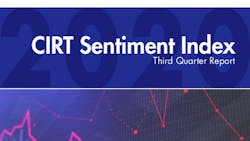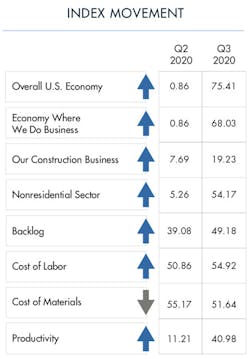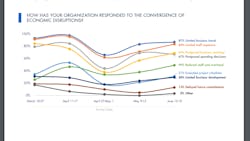Confidence Rising Among Industry Roundtable Execs
PRESS RELEASE
Raleigh NC, July 9, 2020 | FMI Corporation has released the results of its third-quarter, 2020 CIRT Sentiment Index, which experienced a return of optimism compared to last quarter’s results. The Sentiment Index surged from 21.6 to 52.1, while its component Design Index increased from 39.8 to 49.3, historic rises in both measures. This rebound appears to reflect improved confidence through the end of the year, particularly compared to the significant losses experienced during the second quarter.
Government stimulus, relaxing of social distancing restrictions, states reopening businesses and travel, as well as improved client confidence have all contributed to improved expectations, especially across construction-focused members. However, if the Design Index continues to remain below 50, it would tend to indicate or suggest fewer construction opportunities in the future.
Conducted quarterly by FMI, the CIRT Sentiment Index surveys members of the Construction Industry Round Table. Started in 1987, the exclusive group is composed of 115-120 CEOs from leading architectural, engineering and construction firms doing business in the United States. This quarter’s current issues questions polled CIRT membership on perceived changes in worker productivity, compensation adjustments, sources of news information, and U.S. versus international recovery.
Over the past quarter, CIRT members were asked, on an ongoing basis a series of questions addressing organizational response and industry impact of the various economic disruptions seen through the first half of the year (including COVID-19, depressed oil prices, market volatility, etc.). Since March, nearly all respondents have limited business travel and staff exposure both on-site and at the office, while nearly half have reduced staff and overhead.
Notwithstanding over time, it is encouraging to track receding organizational response, particularly fewer postponed spending decisions, meetings and project schedules. Similarly, fewer project disruptions over time have been associated with state and local restrictions, resource availability and/or decline in labor productivity. However, industry demand modifications over the same periods indicate an increasing share of respondents have experienced postponed or canceled projects due to shifting owner- or economy-related dynamics.
Current issues topics in this quarter’s survey addressed perceived change in worker productivity, compensation adjustments, sources of news information and U.S. versus international recovery. Just over half of all respondents reported productivity declines on active job sites following social distancing policies (52%), and just under one-third reported lower productivity among office staff (31%). Going forward, most remote work policies will include more flexibility (89%).
For domestic and international social, economic and political news, respondents primarily rely on newspapers (62%) and television news networks (52%). For design and construction industry news, respondents most frequently utilize internet news aggregators (65%) and magazines (59%). Lastly, 50% of respondents expect the U.S. will recover faster compared to other foreign countries, while (23%) see the timing about the same with another (21%) that suggest recovery timing and performance will be mixed. Only (5%) expect U.S. will be slower compared to other foreign countries.
Among the industries represented by CIRT’s member base, lodging, office, education and international work are projected to experience the biggest short-term declines across both the design and construction industries. The design industry’s long-term view of project growth remains positive, with every sector tracking above 3.0. The construction industry’s long-term view is similarly optimistic, with just two of the 10 sectors projected below 3.0 (lodging and office).
###########
For more analysis, please contact FMI senior economist Brian Strawberry, [email protected].


